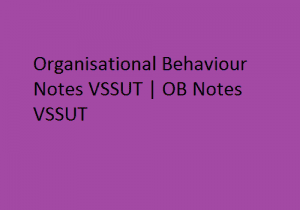Organizational Behavior PDF VSSUT – Complete Notes

Please find the download links of Organizational Behavior Notes PDF VSSUT PDF VSSUT are listed below:
Link: Complete Notes
Module – 1
OB: Learning objectives, Definition & Meaning, Why to study OB, An OB model,
New challenges for OB Manager, LEARNING: Nature of learning, How learning occurs, Learning & OB ,Case Study Analysis ,
KEY ELEMENTS OF ORGANISATIONAL BEHAVIOUR,
BASIC APPROACHES OF ORGANISATIONAL BEHAVIOR,
NEED FOR STUDING ORGANISATIONAL BEHAVIOUR,
CHALLENGES AND OPPORTUNITIES FOR ORGANISATIONAL BEHAVIOUR INTRODUCTION,
SIGNIFICANT PROBLEMS IN MANAGEMENT,MODELS OF ORGANIZATIONAL BEHAVIOR.
Link: Module – 1
Module – 2
PERSONALITY,INTRODUCTION ,PERSONALITY DETERMINANTS ,
FAMILY & SOCIAL FACTORS,CULTURAL AND RELIGIOUS FACTORS,
KEY PERSONALITY TRAITS RELEVANT TO WORK BEHAVIOR,PERSONALITY TYPES (MBTI) ,
OTHER KEY PERSONALITY CHARACTERISTICS RELEVANT TO WORK PLACE,
Authoritarianism and Dogmatism, Type A and Type B Personality ,Tolerance for Ambiguity ,
Role of Personality in Organizational Behavior, FACTORS AFFECTING PERCEPTION/PERCEPTUAL DISTORTION/PERCEPTUAL ERROR ,
FACTORS RELATED THE PERCEIVER,FACTORS RELATED TO THE PERCEIEVED ,
PERCEPTUAL PROCESS, Figure and Ground,
PERCEPTION AND ITS APPLICATION IN ORGANISATIONS ,
Implications of Perception on Performance and Satisfaction ,MOTIVATION ,
Nature of Motivation ,Importance of Motivation, THEORIES OF MOTIVATION ,
Physiological Needs ,Love and Belonging Needs ,Self-actualization Needs ,
Implications of Maslow’s Hierarchy of Needs Theory ,Herzberg Two-Factor Theory of Motivation ,
Motivating Factors ,Implications for Managers, ERG Theory.
Link: Module – 2
Module – 3
COMMUNICATION,INTRODUCTION ,ELEMENTS OF COMMUNICATION,
TYPES OF COMMUNICATION, Downward communication, Upward communication,
Lateral/Horizontal Communication, Diagonal Communication, Formal Communication,
Informal communication, Verbal Communication, Written Communication,
Nonverbal/Gestural communication ,FUNCTIONS OF COMMUNICATION ,
BARRIERS TO EFFECTIVE COMMUNICATION,OVERCOMING BARRIERS TO COMMUNICATION,
Information Communication and Information Centers, Exception principle and need to know,
Being empathetic in understanding, Using feedback mechanisms,
Minimize Physical distraction,
GROUPS, INTRODUCTION ,TYPES OF GROUPS ,Formal groups, Task or Project Groups,
Interest and Friendship Groups.
Link: Module – 3
Module – 4
ORGANISATIONAL CULTURE,Features of Organisational Culture,
Factors determining org. culture,Functions of Organisational Culture ,
Transmission of organizational Culture/How is culture learnt,ORGANISATIONAL CHANGE ,
FACTORS AFFECTING CHANGE,Competitive Market Force,RESISTANCE TO CHANGE ,
Organizational Resistance,OVERCOMING RESISTANCE TO CHANGE ,
LEWIN’S MODEL OF CHANGE/APPROACHES TO MANAGING ORG. CHANGE/PLANNED CHANGE.
Link: Module – 4
Organizational Behavior Notes PDF – VSSUT | OB B.Tech Notes 2025


OB Notes PDF
Are you searching for comprehensive study materials for Organizational Behavior (OB) for B.Tech 2025? This guide will help you access detailed lecture notes from VSSUT (Veer Surendra Sai University of Technology). These notes include the complete syllabus, case studies, and practical insights into organizational behavior.
The Organizational Behavior (OB) PDF notes cover essential topics like personality traits, motivation theories, communication models, organizational culture, and change management, following the VSSUT curriculum.
Organizational Behavior PDF Lecture Notes – VSSUT
The Organizational Behavior (OB) course is critical for students to understand how individuals and groups interact within an organization. These notes are tailored for B.Tech students at VSSUT and help in mastering the core principles that govern behavior in organizational settings.
These notes are an excellent resource for students who need both quick reference and in-depth understanding of the subject, which will be useful during their exams.
Organizational Behavior Notes PDF | OB B.Tech (2025)
Organizational Behavior (OB) is one of the essential subjects in management and engineering courses. This guide includes downloadable PDF links, a syllabus overview, and a description of the topics covered in the VSSUT curriculum.
Overview: OB Notes PDF
The Organizational Behavior (OB) notes provide insights into individual and group dynamics within an organization. The study material is organized into modules, making it easier for students to grasp topics such as learning processes, motivation theories, personality traits, communication techniques, and organizational culture. The material is designed to equip students with the knowledge to effectively analyze and manage organizational dynamics.
These notes also include practical examples and case studies that help students apply theoretical concepts to real-world organizational scenarios.
The Following Topics Are Covered in OB Handwritten Notes:
- Module 1: Organizational Behavior Fundamentals
- Learning Objectives: Key elements and learning goals of OB
- Definition and Meaning of OB: Understanding OB’s significance in management
- OB Model: Exploring the models and frameworks for studying OB
- Challenges for OB Managers: Understanding the modern challenges that managers face
- Learning and OB: How learning impacts behavior within organizations
- Key Elements and Basic Approaches to OB: Core elements that define organizational behavior
- Problems in Management and Models of OB: Insight into managerial issues and how OB models help in solving them
- Module 2: Personality and Perception in OB
- Personality Determinants: Exploring factors such as family, society, culture, and religion
- Personality Types and Traits: Including MBTI, Type A and Type B personalities, and their relevance in the workplace
- Perception in OB: Factors influencing perception, including perceptual distortions and errors
- Theories of Motivation: Comprehensive study of Maslow’s Hierarchy of Needs, Herzberg’s Two-Factor Theory, and ERG Theory
- Implications for Managers: How personality and motivation theories influence management practices
- Module 3: Communication and Groups in Organizations
- Types of Communication: Exploring downward, upward, lateral, formal, and informal communication in organizations
- Barriers to Communication: Identifying and overcoming communication barriers in an organizational setting
- Functions of Communication: How communication supports organizational goals
- Groups in Organizations: Types of groups including formal, informal, project groups, and friendship groups
- Module 4: Organizational Culture and Change
- Organizational Culture: Features, factors, and functions of culture within an organization
- Transmission of Culture: How culture is learned and passed within organizations
- Organizational Change: Factors affecting organizational change, resistance to change, and how to manage it effectively using Lewin’s Change Model
Links to Download OB Notes PDF
You can download the Organizational Behavior (OB) PDF notes for each module using the links provided below:
- [Complete Notes Download Link]
- [Module 1: Organizational Behavior Fundamentals]
- [Module 2: Personality and Perception]
- [Module 3: Communication and Groups]
- [Module 4: Organizational Culture and Change]
OB Notes and Study Material PDF Free Download
The OB notes provided here are freely available in PDF format. These notes offer a structured way to prepare for exams, with clear explanations of the fundamental theories and practical applications of organizational behavior.
Topics Covered in This OB Notes PDF
- Module 1: Introduction to Organizational Behavior: Learning objectives, key elements, challenges for OB managers, and models of organizational behavior.
- Module 2: Personality, Perception, and Motivation: The role of personality in OB, perception theories, motivation theories including Maslow, Herzberg, and ERG.
- Module 3: Communication and Groups: Different communication types, barriers to effective communication, and the function of groups within organizations.
- Module 4: Organizational Culture and Change: Understanding culture in organizations, managing resistance to change, and strategies for planned change.
OB Notes PDF from VSSUT
These Organizational Behavior Notes are designed according to the syllabus of Veer Surendra Sai University of Technology (VSSUT), ensuring that students are well-prepared for their exams. With practical case studies, learning objectives, and a focus on key management issues, these notes will help students build a comprehensive understanding of organizational behavior concepts.
Always Choose Smartzworld to Download OB Notes PDF
Smartzworld is a reliable source for downloading high-quality notes, especially for engineering and management students. By choosing Smartzworld, you get access to comprehensive and organized notes, specifically crafted for exam preparation and success.
Benefits of Free OB Handwritten Notes PDF:
- Complete Coverage: These notes cover every topic in detail, following the curriculum of VSSUT.
- Structured Learning: The material is organized into modules, making it easier to study.
- Prepared for Exams: The content is exam-focused, with key topics and questions highlighted.
- Free and Accessible: These notes are available for free download, and you can access them on any device.
- Case Study Analysis: Practical insights into real-world applications of organizational behavior concepts.
FAQs
Q1. Where can I download the Organizational Behavior Notes PDF?
You can download the Organizational Behavior notes from the provided links for each unit or the complete set from Smartzworld.
Q2. How to download the OB Notes PDF?
Simply click on the provided links above, which will redirect you to the downloadable PDF notes for each module.
Q3. How many modules are covered in the OB Notes PDF?
The OB Notes are divided into four modules:
- Module 1: Organizational Behavior Fundamentals
- Module 2: Personality and Perception
- Module 3: Communication and Groups
- Module 4: Organizational Culture and Change
Q4. What topics are covered in the OB Notes PDF?
The notes cover topics such as learning objectives, personality traits, motivation theories, communication types, organizational culture, and change management.
Q5. Where can I get the complete OB Handwritten Notes PDF FREE Download?
The complete handwritten notes for Organizational Behavior are available for free download from Smartzworld.
Q6. How to download OB Handwritten Notes PDF?
You can download the handwritten notes by visiting the provided links in the document or directly accessing Smartzworld for free resources.
Q7. How to Download Free OB Notes PDF?
To download the free notes, follow the links shared above, which will take you to the downloadable PDF versions of the study materials.
By following this guide, students can effectively prepare for their Organizational Behavior (OB) exams and gain a deeper understanding of how individuals and groups interact within organizations.


